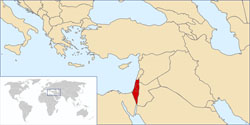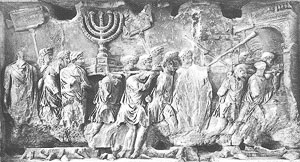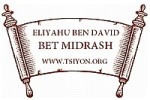Lost Ten
Tribes and Judaism
Many Jewish
rabbis of the past and present acknowledge that the ten
tribes of the Northern Kingdom of Israel were exiled from
the Land by the Assyrians, remain in exile as distinct from
Judaism, and have yet to return to the Land as prophesied in
Scripture. For example, the Jewish Encyclopedia
explains how this came about:
According
to the Bible, Tiglath-pileser (II Kings xv. 29) or
Shalmaneser (ib. xvii. 6, xviii. 11), after the defeat
of Israel, transported the majority of the inhabitants
of the Northern Kingdom to Assyria, and placed them in
Halah and Habor, on the stream of Gozan, and in the
towns of Media. In their stead a mixed multitude was
transported to the plains and mountains of Israel [These
became known as Samaritans]. As a large number of
prophecies relate to the return of "Israel" to the Holy
Land, believers in the literal inspiration of the
Scriptures have always labored under a difficulty in
regard to the continued existence of the tribes of
Israel, with the exception of those of Judah and Levi
(or Benjamin), which returned with Ezra and Nehemiah.
...In the Apocrypha it is presumed that the Ten Tribes
still exist as tribes. Thus Tobit is stated to be of the
tribe of Naphtali, and the Testaments of the Twelve
Patriarchs assume their continuous existence. In the
Fourth Book of Ezra (xiii. 39-45) it is declared that
the Ten Tribes were carried by Hosea, king in the time
of Shalmaneser, to the Euphrates, at the narrow passages
of the river, whence they went on for a journey of a
year and a half to a place called Arzareth. Schiller-Szinessy
pointed out that "Arzareth" is merely a contraction of "erez
aheret," the "other land" into which the Lord says He
"will cast them [the people] as this day"; see Deut.
xxix. 27, which verse is referred by R. Akiba to the
Lost Ten Tribes (Sanh. x. 4; comp. "Journal of
Philology," iii. 114). [TRIBES, LOST TEN: Jewish
Encyclopedia]
These Biblical
facts are affirmed by many of Judaism's leading rabbis; that
Ten Lost Tribes exist apart from the tribes of Judah, Levi
and Benjamin, which three tribes collectively became known
as "Jews". The non-Jewish Ten Tribes Biblically hold equal
claim to the title "Seed of Abraham, Isaac and Jacob" along
with the known Jewish tribes. To the "seed" of Israel has
the Land of Israel been promised. Therefore, what is true
for the "Jew" regarding the Land of Israel holds equally
true for the Lost Ten Tribes as well. Unfortunately and
inaccurately, it has become common to speak of Jews as
synonymous with Israelites. Of course, Jews ARE Israelites,
but they are not ALL Israel, as the scattered Remnant of
Israel, the rest of Israel, well know. With that in mind,
please substitute "Israel" and "Israelites" for "Jews" and
"Judaism" as you read the following article, and
you will come pretty close to the truth for most of this,
with exceptions speaking specifically of religious Judaism.
Judaism and [the Land of]
Israel
Article by: NSW Board
of Jewish Education
Introduction

This map shows the location of
the modern state of Israel in the world
Jews have
lived in the land of Israel for nearly 4000 years, going
back to the period of the Biblical patriarchs (c.1900 BCE).
The story of the Jewish people, Israel, its capital,
Jerusalem, and the Jewish Temple there, has been one of
exile, destruction and rebirth. In its 3000 years of history
Jerusalem has been destroyed 17 times and 18 times reborn.
There has always remained a Jewish presence in the land of
Israel and in Jerusalem, and the Jewish people as a whole
always dreamt of returning to and rebuilding it.
The concluding
words of Israel's national anthem, HaTikvah (The Hope)
summarise that aim: “The hope of 2000 years:/ To live as a
free people/ In our own land,/ The land of Zion and
Jerusalem.”
From Biblical
Israel to 70 CE
(Destruction of the Temple)
The story of
Jewish life in ancient Israel is recorded in detail in the
Hebrew Bible (called the "Old Testament” by Christians).
According to the Bible, the history of the Jewish people
begins with Abraham, and the story of Abraham begins when
God tells him to leave his homeland, promising Abraham and
his descendants a new home in the land of Canaan. (Gen. 12).
Canaan was later renamed Israel, after Abraham's grandson,
Jacob/Israel. The land is also often referred to as the
Promised Land because of God's repeated promise (Gen. 12:7,
13:15, 15:18, 17:8) to give it to the descendants of
Abraham.
When Jacob
(also known as Israel) encountered the site on Mount Moriah
where centuries later the Temple would stand, he said: "How
awe-inspiring is this place! It is the House of God! It is
the gate to heaven!" (Gen. 28:17). He was told Jerusalem was
"the site that the Lord your God will choose from among all
your tribes, as a place established in His name. It is there
that you shall go to seek His presence" (Deut. 12:3).
Jerusalem
began to fulfil the function of a spiritual and national
capital for the Jews in the 10th century BCE when King David
conquered it. He made Jerusalem his seat of judgment and
took the Ark of the Covenant to rest there. It was David who
conceived the idea of building a Temple there as a permanent
house of God, a plan eventually fulfilled by his son
Solomon.
The Temple in
Jerusalem was the centre of Jewish religion and life from
the time of Solomon to its eventual destruction by the
Romans in 70CE. It was the one and only place where services
and certain other religious rituals were performed. Three
times a year, on the harvest holydays of Passover, Pentecost
and Tabernacles, the entire Jewish nation would make a
pilgrimage there.
It is in the
direction of Jerusalem that Jews face when they pray three
times daily. The prayers themselves contain numerous
references to Jerusalem and Zion. In the Amidah, the Silent
Devotion, God is praised as the Builder of Jerusalem. In
many other places the prayers echo the messianic belief that
God will restore the Jewish people to His holy city. On
Passover and the Day of Atonement, Jews conclude services
with the fervent hope: "Next year may we be in Jerusalem!"
When the
Babylonians destroyed the city in 586 BCE, they also
partially destroyed the Temple. The Jews, sent into exile by
this event, pledged that they would never forget their
beloved Jerusalem or its Temple:
"By the
rivers of Babylon, there we sat down, and we wept, when
we remembered Zion. How shall we sing the Lord's song in
a foreign land? If I forget thee, O Jerusalem, let my
right hand wither. Let my tongue cleave to the roof of
my mouth, if I remember thee not; if I set not Jerusalem
above my chiefest joy" (Psalms 137:1-6).

The Arch of Titus in Rome portrays the
Temple in Jerusalem being looted in 70CE by Roman
soldiers
In 165 BCE the
Temple was rededicated after Jewish soldiers succeeded in
recapturing Jerusalem. The Romans destroyed this Second
Temple in 70 CE, for them a victory of such significance
that they commemorated it by erecting the triumphal Arch of
Titus, which still dominates the Roman Forum.
Jerusalem’s
famous Wailing Wall is the remains of the western retaining
wall of the Temple, and it is as close to the site of the
original Sanctuary as Jews can go today. The site of The
Temple is now occupied by a Muslim Mosque called the Dome of
the Rock.
When the
Emperor Hadrian later began planning to replace the
destroyed Second Temple with a shrine to Jupiter, a Jewish
revolt known as the Bar Kochba Rebellion broke out. This
revolt broke out in 135 CE and some 580,000 Jewish soldiers
were killed; following the revolt, the Emperor Hadrian
decreed that the name "Judea" (which was then the name by
which the land of Israel was known) should be replaced by "
Palestina", the Latin name for Philistia, the land of the
Philistines, an ancient people who had invaded and occupied
part of the land of Israel but who disappeared from history
at the time of the Babylonian conquest of the region.
Emperor Hadrian's motivation for doing this was simple - the
name Judea was derived from Judah, the name of the largest
Jewish tribe, and its use implied that the land was Jewish,
whereas Hadrian wished to teach the Jews that Rome, and not
they, now controlled the land and everything about it,
including what name was given to it.
In the years
following the destruction of the Second Temple, the greater
part of the Jewish population went into exile as captives,
slaves and refugees, although Galilee remained a centre of
Jewish institutions and learning until the sixth century CE.
For the past 2000 years, on the 9th day of the Hebrew month
of Av, Jews everywhere have commemorated the destruction of
their city and Temple with a 25-hour fast. They sit on low
stools in their synagogues and recite Jeremiah's
Lamentations. They recite elegies for the city which is
"scorned without her glory".
The Importance
of Jerusalem in Judaism
"Jews care
intensely about Jerusalem. The Christians have Rome and
Canterbury and even Salt Lake City; Muslims have Mecca
and Medina. Jerusalem has great meaning for them also.
But the Jews have only Jerusalem, and only the Jews have
made it their capital. That is why it has so much deeper
a meaning for them than for anybody else...."
(Teddy Kollek, Mayor of Jerusalem from 1965-1993).

A panoramic view of the modern city of
Jerusalem. (Photo courtesy of Wikimedia Commons)
Throughout its
long and turbulent history, Jerusalem, more than any other
city, has evoked the emotions, aspirations, yearnings and
religious fervour of civilised mankind. Yet this homage of
the world cannot overshadow the consuming and single-minded
passion of one particular attachment: that of the Jewish
people. For that people, as no other, Jerusalem is not just
its one and only religious centre and source of spiritual
life; from time immemorial it has been and, still is, the
very heart and core of the people - the tangible embodiment
of its nationhood, the lodestar in its wanderings, the theme
of its prayers each day, the fulfilment of its dreams for
the Return unto Zion and indeed the cornerstone of its
continuity.
There has been
a Jewish presence in the city of Jerusalem over the
centuries, despite the massacres and deprivation brought
about by its ruling powers and invading armies. The only
times Jews did not live in the city were in the period
immediately after the Roman destruction and for a short time
during the Crusades, which was also the only period when
Jerusalem was a capital city for a non-Jewish group: from
1099 with the founding of the Latin Kingdom of Jerusalem.
The city has always been the designated national capital of
the Jews. It was home to the Jewish kings, the Sanhedrin and
the High Priests. In 1948 it automatically became the
capital of the State of Israel.
In October
1995, the US Congress passed the Jerusalem Embassy Act which
recognised Jerusalem as the united capital of Israel and
authorised the relocation of the US Embassy from Tel Aviv to
Jerusalem. The then US Senate majority leader, Robert Dole,
stated: "Yesterday's vote to relocate the American Embassy
to Jerusalem was truly a bipartisan effort... No other city
on earth represents the same capital of the same country
inhabited by the same people, speaking the same language and
worshipping the same God as it did 3,000 years ago."
Judaism in
Israel Today
In Israel’s
Declaration of Independence, the desire is expressed to
reflect the historical, cultural and spiritual centrality of
the Land of Israel in its statehood, and its openness to
Aliyah. This is achieved by Public holidays being observed
on Jewish Festivals; the IDF, most hospitals and public
services, ensuring that the food they serve is Kosher, and
such. The Declaration also promises that the State of Israel
"will ensure complete equality of social and political
rights to all its inhabitants irrespective of religion, race
or sex; it will guarantee freedom of religion, conscience,
language, education and culture; it will safeguard the holy
places of all religions..."
About one
quarter of Israel’s Jewish population observe some
traditions, while another 20% say they go to the synagogue
on Yom Kippur (=70%) and another 8% (=78%) say that they
fast on Yom Kippur but stay at home. A similar percentage
observe the Seder gathering in some form on the first night
of Pesach. Some other traditional practices observed in a
limited way by the Hiloni (secular) of Israel are lighting
the Shabbat candles, or keeping kosher to some extent. This
is rare practice amongst American Reform Jews, and unheard
of among secular American Jews.
Even though
this reveals that most Israelis do not formally identify
themselves with a movement, Orthodoxy is the only movement
that is formally and legally recognised in Israel. Religious
councils were served only by Orthodox Jews until recently,
and matters such as marriage, conversions and divorce are
controlled by the Orthodox Rabbinate.
There is a
strong movement to de-institutionalize Judaism as the state
Religion, in terms of its impact on individual free will and
practice, issues of pluralism and on personal status. Under
Israel, freedom of religion has been guaranteed for all
faiths in Israel and particularly in Jerusalem. By contrast,
between 1948 and 1967, under the rule of Jordan in East
Jerusalem, 54 synagogues were destroyed in the Old City;
gravestones from the ancient Jewish cemetery on the Mount of
Olives were used as paving stones; and Jews were expelled
from the sector. Under Article 8 of the Israeli-Jordanian
Armistice agreement of April 1949, free access to the
Western Wall and Mount Scopus was supposed to be guaranteed
to the Jews, but the Jordanians never allowed it.
Immediately after the Israeli reunification of Jerusalem,
the Protection of Holy Places Law was passed by the Knesset,
on 22 June 1967, guaranteeing the sanctity of all holy
sites. This law imposes prison sentences of up to seven
years on those who desecrate such places. The 1980 Basic Law
on Jerusalem as the capital of Israel reaffirmed the
principle of free access to the holy sites of all religions.
Israel permits
Christians and Muslims to administer their own holy places
and institutions. Jordan still administers the Muslim holy
sites in the city. In 1988 King Hussein exempted Jerusalem
when he ended his administrative ties with the West Bank,
and the October 1994 Israel-Jordanian peace treaty agrees on
respecting "the present special role of the Hashemite
Kingdom of Jordan in the Muslim holy shrines in Jerusalem".
C. Witton Davies, Archdeacon of Oxford, wrote after a visit
to Jerusalem: "From my own personal conversations and
observations, I testify that Jerusalem has never been so
fairly administered, or made accessible to adherents of all
three monotheisms, as well as to the general tourist
sightseer or visitor."
Former US
President Jimmy Carter, a devout Southern Baptist and an
outspoken exponent of human rights, has acknowledged the
freedom of religion in East Jerusalem under Israeli rule:
"There is unimpeded access today. There wasn't from
1948-1967."
In April 1990,
the chairman of the US House of Representatives Foreign
Affairs Committee, Dante Fascell, noted on the floor of
Congress that "since Israel gained control of the (Old) City
in 1967, it has been open to worshippers of all faiths."
Israeli rule
has not been perfect, yet it has effectively safeguarded the
religious freedom of Christians, Muslims and Jews and their
holy places.
The Historic
Jewish Capital of the Historical Jewish Land
For 3000 years
Jews have turned towards Jerusalem for spiritual, cultural,
and national inspiration. After the destruction of the city,
by the Romans almost 2000 years ago, foreign powers ruled
the city vanquishing its inner beauty. Today the beauty has
returned to the city. Jerusalem has once again truly become
the centre of the Jewish people. The adage of the Talmudic
sages has now been fulfilled: "Ten measures of beauty were
bestowed upon the world; nine were taken by Jerusalem."
Through the
centuries of exile, the hope for redemption of Jerusalem and
the land of Israel remained a focal point of the Jewish
religion and national identity. Today there are about 14
million Jews in the world, of whom nearly five million live
in Israel, almost half a million in Jerusalem.
This is an
excerpt from an address by Israeli Prime Minister Yitzchak
Rabin, given at the inauguration of the Jerusalem 3000
festivities on 4 September 1995 - two months before his
assassination:
“Three
thousand years of history look down upon us today, as do
the dreams which cover the hyssop of the Western Wall
and the silent graves of the Mount of Olives and Mount
Herzl; the hush of the footsteps of the pilgrims and the
thunder of the nailed boots of the ruthless conquerors;
whose walls resonate with the prayers of the children
and the pleas of the praying; where the exultation of
victory mingled with the tears of the paratroopers next
to the remnants of the Temple, liberated from the yoke
of strangers. Three thousand years of dreams and prayers
today wrap Jerusalem in love and bring close Jews of
every generation - from the fires of the Inquisition to
the ovens of Auschwitz, and from all corners of the
earth - from Yemen to Poland. Three thousand years of
Jerusalem are for us, now and forever, a message for
tolerance between religions, of love between peoples, of
understanding between the nations, of the penetrating
awareness that there is no State of Israel without
Jerusalem, and no peace without Jerusalem united - the
City of Peace. On the day that the government offices
were moved to Jerusalem, on 13 December 1949, the first
Prime Minister, David Ben Gurion, said: ‘The State of
Israel has, and will have, only one capital, Eternal
Jerusalem. So it was 3000 years ago and so it will be,
as we believe, for eternity’."
 Jacob ..dreamed.
Jacob ..dreamed.









 Tsiyon
Road on Glorystar Satellite!
Tsiyon
Road on Glorystar Satellite!


